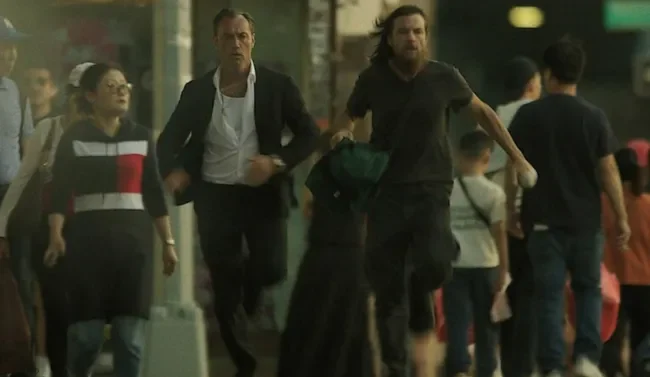How production designer Alex DiGerlando created fictional Black Rabbit

Look closely while watching Netflix’s crime thriller Black Rabbit, and you’ll not only see a fully functioning, hip NYC restaurant that serves as the series’ center piece, but one that was specifically designed for the series. Although it looks like series stars and onscreen siblings Jude Law and Jason Bateman are in a real restaurant, the fictional Black Rabbit is a set.
“It seemed like an interesting challenge,” says series production designer Alex DiGerlando. “Designing for the real world is of course very different from designing for film and television. But this was sort of like the closest thing to designing a real world restaurant.” He joined our recent “Meet the Experts: Spotlight” panel for Emmy-contending production designers.
The two-time Emmy nominee (for his art direction on True Detective and production design on Fosse/Verdon) said he and the creative team knew early on that they were going to have to build their own Black Rabbit vs. trying to film in an actual New York restaurant. “We knew just from the sheer number of pages that were going to be shot in that space was going to require a level of control that probably wouldn’t be able to be done on a location,” he explains. “We were looking for an exterior location that would then inform the design of the inside, but I think we knew that we were going to build it.”
DiGerlando, whose work has graced screens big and small, including production design for Beasts of the Southern Wild and Tick, Tick… Boom, talked about the fun of making a working restaurant for cast and crew to shoot in, the real NYC structure that inspired it, along with a few TV magic tricks used to make certain materials look hundreds of years old or hand carved.
Gold Derby: For people who might not yet be familiar with the series, can you talk about the Black Rabbit itself? What the restaurant is and what kind of people populate it?
Alex DiGerlando: The Black Rabbit is this restaurant that was started by these two brothers who were members of a band that had some moderate success in the late ’90s, early 2000s, and then kind of fizzled out. They kind of started a second career as restaurateurs, which then sort of hits its own snags and the brothers kind of part ways before our story begins. So because of their rock and roll backgrounds, the idea was to make a restaurant that had that feeling of Jimmy Page or Mick Jagger’s estate, something that felt like an inn that you might stumble across after traveling through the countryside. We wanted something that had a certain amount of history to it and 279 Water Street sort of proved to be that for us.
What do you love about having a setting like New York City and referencing a real building? I think in episode two there’s a flashback where you get to use the location?
Yeah, so anytime you see the exterior, that’s the real building, 279 Water Street. And then in the beginning of episode two, when they kind of discover the place and they see how decrepit it is, but they have a vision for what it can be, that’s actually the real place. And that’s the condition it’s in now. A lot of the beautiful decay that is going on in that space, we pulled on for our stage build. There’s the wallpapers that we recreated and woodwork that we replicated. This building was a little grocery that was built in the late 1790s, almost a century before the Brooklyn Bridge was built. It has this storied history, there were several different bars and eateries there over time. There was this one pub called The Hole in the Wall that was a pirate hangout and there are legends of people’s ears getting ripped off in fights and then kept in a pickle jar on the counter of the bar, and talk of a brothel that was operating upstairs. We kind of pulled all of that mythology, whether it was true or not, into the mythology of the Black Rabbit. And that informed a lot of the texture that we designed into the set.
Is there a part of the show or an episode or a set piece where you feel like you pulled off some magic as far as it comes to like, you know, movie magic or something that you would love for audiences when they see it again, maybe to kind of look out for?
This may be too technical to be interesting, but the actual building had this beautifully carved wood banister. It makes this very graceful turn as it gets up to the top of stairs and we wanted to replicate that in our set because you’ll see it in the flashback sequence. And we wanted to have that in our set but there just wasn’t lead time to have it made. First of all, there’s not the artisans that can carve that way now. That original banister was carved by hand like a hundred years ago. And now, to get that done, it would have taken more time than we had to get it made. So our scenics came up with this really ingenious way of making a cast of the straightaway portion of the banister, out of a soft cast in a rubber-type material, using the rubber to turn the bend and then cast that again in a harder material so that we could have that curve. Hopefully you would never know, but the restaurant’s filled with all these, as you say, magic tricks to make these details pop.
This article and video are presented by Netflix.





